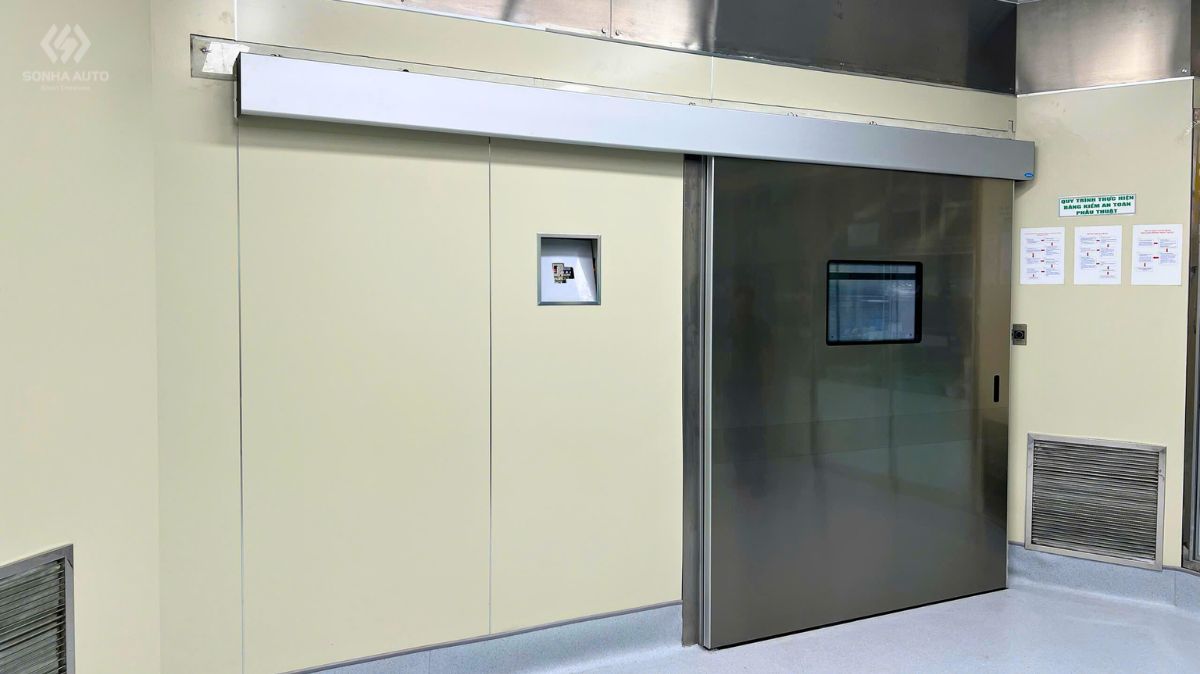In medical and high-tech manufacturing environments where cleanliness and environmental control are critical—a standard door cannot meet strict airtightness requirements. In highly sensitive areas such as operating rooms or cleanrooms, preventing air exchange and contamination from the outside is a top priority. This demand has led to the development of a specialized solution: the airtight door. So, what is an airtight door and why has it become an essential component in advanced medical and industrial projects? This article provides a comprehensive overview of the concept, functions, structure, and technical standards of modern automatic airtight door systems.
What is an airtight door?
An airtight door, also known as a hermetic sealing door, is a specialized door engineered with a mechanism that allows the door leaf to press tightly against the frame and floor when closed. This creates a completely sealed barrier that prevents air leakage, dust, bacteria, and noise while maintaining stable pressure differences between rooms. Airtight doors are widely used in healthcare (operating rooms, laboratories), cleanrooms, cold storage, and other modern facilities.

How airtight doors differ from standard automatic doors?
| Criteria | Automatic airtight door | Standard automatic door |
| Closing mechanism | Presses tightly into the frame, creating an airtight seal | Closes against the frame with small gaps |
| Airtightness | Nearly absolute (extremely low air leakage, medical-grade) | Low; suitable only for basic wind/dust control |
| Materials | Antibacterial, chemical-resistant (stainless steel, HPL) | Tempered glass, aluminum |
| Main applications | Operating rooms, cleanrooms, pressure-controlled rooms | Building lobbies, malls, airports |
Airtight doors are considered a decisive factor in the success of environmental control systems. They play a core role in hospital entrance solutions, ensuring surgical areas and isolation zones remain fully sterile and preventing the spread of pathogens and harmful gases.
The role of airtight doors in environmental control
When learning what is an airtight door, the most important aspect is understanding its role in maintaining controlled environments in critical areas such as operating rooms, cleanrooms, isolation rooms, and laboratories. Airtight doors not only prevent unwanted air exchange but also preserve sterile conditions, ensuring safe and stable medical and technical operations.
Maintaining pressure differentials between rooms
One of the most critical functions of airtight doors:
- Positive pressure: In hospital operating rooms, indoor pressure is kept higher than outside. When the door opens, clean air flows outward, preventing contaminated air from entering.
- Negative pressure: In isolation rooms or waste-processing areas, pressure is kept lower to ensure contaminated air is drawn inward, preventing it from escaping into corridors. Airtight doors are mandatory to maintain this condition.
Reducing contamination, dust, and impurities
Airtight doors minimize uncontrolled airflow entering cleanrooms, helping to:
- Reduce cross-contamination risks in surgery and recovery zones
- Prevent dust, particles, and microorganisms from entering
- Maintain cleanroom conditions throughout operation
Enhancing HVAC efficiency and reducing energy costs
HVAC (Heating, Ventilation, and Air Conditioning) systems regulate temperature, humidity, and air quality. By preventing loss of conditioned air, airtight doors improve HVAC efficiency, maintain stable room conditions, and reduce energy consumption significantly.
Thus, airtight doors not only ensure environmental control but also deliver long-term economic benefits for hospitals and cleanroom facilities.
Structure of hospital airtight doors
The specialized construction of airtight doors is what distinguishes them. Each component is engineered to ensure sealing performance, pressure retention, and contamination prevention in high-cleanliness spaces.

Door leaf and frame
Made from antibacterial, corrosion-resistant materials such as stainless steel, electro-galvanized steel, composite, or HPL durable, hygienic, and ideal for medical environments.
Airtight gaskets
The most critical component, usually made of high-elasticity EPDM or silicone, providing:
- High heat and chemical resistance
- Excellent sealing performance
When the door closes, the gasket is compressed tightly against the frame to seal all gaps.
Specialized sliding rails or hinges
The sliding track of an automatic airtight door is designed with a more complex structure to integrate the mechanism that lowers the door toward the floor and presses it tightly against the frame. Depending on project requirements, either of these mechanisms can be used, as both designs help ensure maximum airtightness when the door is closed.
- The airtight sliding track ensures smooth door movement and minimizes vibration.
- Specialized hinges for swing-type airtight doors help the door close firmly and maintain even pressure on the sealing gasket.
Motor, sensors, and interlock locks
- Quiet, vibration-free motors
- Contactless sensors for hygiene
- Interlock systems ensuring only one door opens at a time (airlocks)
Observation window
Some airtight doors are equipped with flat observation windows made of tempered glass or antimicrobial glass. The glass edges are fully sealed to prevent any gaps, allowing staff to observe inside without opening the door and minimizing pressure loss to the greatest extent.
Operating principle of airtight doors
Airtight doors operate as follows:
- Sealing mechanism when closing: For sliding doors, when the system receives the closing signal, the door panel moves horizontally. At the final position, the panel slightly drops downward and presses tightly against the frame (the down-and-in mechanism) to create a perfect seal.
For swing doors, specialized gaskets installed around the door edges automatically compress against the frame when the door closes, ensuring airtight performance. - Achieving standard airtightness: The system is rigorously tested to ensure the lowest possible air leakage (commonly specified as ≤ 3 mm/h leakage under 50 Pa pressure), meeting the requirements of certification bodies.
- Integration with cleanroom pressure systems to maintain a stable environment: Automatic airtight doors work in coordination with the HVAC system. Their tight sealing mechanism helps the HVAC maintain the designed clean environment and pressure levels more efficiently.

Popular types of automatic airtight doors
Understanding what is an airtight door also includes recognizing the common types used today:
- Automatic sliding airtight doors: Most common in operating rooms; space-saving and sensor-friendly.
- Automatic swing airtight doors: Suitable for smaller rooms or areas without sliding wall space.
- Manual airtight cleanroom doors: With airtight gaskets, suitable for lower cleanroom levels.
- Specialized operating room doors (EN-standard): Premium models from NABCO, TORMAX, etc., meeting EN 16361 and strict medical standards.
Airtight door standards
The evaluation standards play a crucial role in ensuring that airtight doors operate correctly in cleanroom environments. The assessment of an airtight door must be based on the following international standards:
- Cleanroom pressure differential standards (ISO 14644): This defines the allowable concentration of dust particles and microorganisms. Operating room doors must help ensure compliance with these cleanroom conditions.
- EN 16361 standard for automatic doors: This ensures safe operation, durability, and specific performance requirements for automatic doors used in medical facilities.
- Permissible air-leakage level: This technical criterion determines the door’s ability to maintain pressure. The lower the air-leakage rate, the better the sealing performance.
- Antibacterial properties and surface hygiene: Materials must be certified for antibacterial performance, and surfaces must be smooth and groove-free to allow easy cleaning and disinfection.
Applications of airtight doors in real-world settings
Understanding what an airtight door is helps you choose the right type for each area. The most common use is in hospital operating rooms, where absolute control of pressure and sterility is required. Isolation rooms and cleanrooms also rely on airtight doors to maintain stable positive or negative pressure and ensure microbiological safety.
Beyond healthcare, airtight doors are widely used in pharmaceutical, food, and electronics cleanrooms to control dust and contaminants. Microbiology laboratories also use airtight doors to prevent cross-contamination. Some specialized areas such as cold storage or preservation rooms that demand strict air sealing—also depend on this type of door.

Choosing the right airtight door
To choose the right airtight door, you should first consider the intended application—such as operating rooms, isolation rooms, laboratories, or industrial cleanrooms. Next, evaluate the door frame and panel materials, along with the sealing performance of EPDM or silicone gaskets, which are the most critical components determining airtightness.
Buyers should also check for certifications such as ISO or EN standards and select reputable brands like NABCO, SWICO, or TORMAX to ensure long-term durability and stable operation. During installation, it is essential to follow proper sealing procedures and adjust the cleanroom pressure correctly. Regular inspections of the motor, sensors, and gaskets are recommended.
The price of an airtight door depends on several factors, including the motor system, sensors, door materials, sealing level, brand, and applicable standards. Each type—such as sliding doors, swing doors, and operating room doors—will have different cost ranges based on its configuration.
>>> See also: What is a hospital door? Learn its structure, standards and common types today
Conclusion
This article has fully answered the question what is an airtight door. It is a critical technological component in any medical or industrial environment requiring strict environmental control. Investing in a certified airtight automatic door is an investment in safety, quality, and long-term energy efficiency.
To ensure absolute airtightness for your hospital operating room doors, trust reputable suppliers.
👉 Contact Sonha Auto today for consultation and installation of international-standard hospital automatic doors and airtight doors from leading brands such as NABCO!



